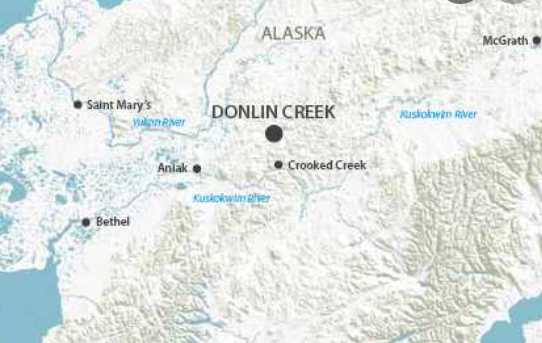
JOINT BASE ELMENDORF-RICHARDSON – Today, the U.S. Army Corps of Engineers and Bureau of Land Management signed a joint record of decision for the Donlin Gold mine project in Alaska. The decision document is the culmination of efforts by both agencies to fulfill the intent of Executive Order 13807 and is the first action of its kind for both agencies nationwide.
During a ceremony at the Corps’ Alaska District headquarters building, Col. Michael Brooks, commander of the Corps’ Alaska District, and Joe Balash, U.S. Department of the Interior’s Assistant Secretary of Land and Minerals Management, penned their names on the document recording the agencies’ findings with respect to their independent regulatory authorities. Donlin Gold representatives also signed and received the applicable authorizations at the event.
“Today, the Corps of Engineers and the Bureau of Land Management came together to sign the first joint record of decision under the President’s One Federal Decision framework,” said R.D. James, Assistant Secretary of the Army for Civil Works. “This signing is proof that different agencies within the federal government can work together, speak with one voice, and move dirt on major infrastructure projects.”
Executive Order 13807, titled “Establishing Discipline and Accountability in the Environmental Review and Permitting Process for Infrastructure,” aims to increase infrastructure investment in order to strengthen the American economy by eliminating inefficiencies in project decisions including the management of environmental reviews, permit decisions or authorizations.
“The Donlin Gold mine project in Alaska is a great example of cooperation between the Corps and BLM. We are proud to have Assistant Secretary Balash and Colonel Brooks sign the first ever joint federal record of decision, which demonstrates our agencies’ commitment to executing the principles outlined in the President’s Executive Order 13807 and the One Federal Decision framework,” said Secretary of the Interior Ryan Zinke. “This important project – which includes stipulations for Alaska Native hiring preference – will bring over 3,000 construction jobs and 1,400 operations jobs to the Yukon-Kuskokwim region of Alaska. It will create good-paying jobs to a region of Alaska with historically high unemployment, and we look forward to realizing the many opportunities that the mine will bring to the state of Alaska and the American people.”
In July 2012, Donlin Gold, LLC applied for a Department of Army permit initiating the need for an environmental impact statement as required by the National Environmental Policy Act. The Corps led the effort with 12 cooperating agencies including the BLM, Pipeline and Hazardous Materials Safety Administration, U.S. Environmental Protection Agency, U.S. Fish and Wildlife Service, Alaska Department of Natural Resources, and six federally recognized Alaska Native Tribes.
The Corps conducted extensive public comment and review periods leading to the publication of the final environmental impact statement in April 2018. This document informed the agencies’ decisions.
“The Corps and BLM in Alaska are pioneering this joint decision to show the public that their federal government can work together and make sound decisions on environmental reviews,” Brooks said. “It is a great step forward.”
Donlin Gold plans to construct and operate an open-pit, hard-rock gold mine in the Kuskokwim River watershed, 277 miles west of Anchorage and 10 miles north of the community of Crooked Creek. With an estimated operational life of 27 years, the project is expected to produce approximately 30 million ounces of gold processing about 59,000 tons of ore per day. Major project components include the proposed mine site, transportation corridor and pipeline. Construction of the project will take about four years. The Kuskokwim Corporation owns the majority of the land at the Donlin site.
A Department of the Army permit is being issued to Donlin Gold for the discharge of fill materials into waters of the U.S., including wetlands, and the construction of structures in and under navigable waters. Impacts to aquatic resources of the U.S. is approximately 3,500 acres of wetlands and 226,000 linear feet of streams. The permit authorizes the applicant’s proposed action as outlined by Alternative 2 North Option in the impact statement – determined by the Corps as the least environmentally damaging practicable alternative. This authorization will require compensatory mitigation.
Furthermore, the BLM is providing a right-of-way grant for the construction of a natural gas pipeline and associated fiber optic cable.
“This joint decision is the first finalized by BLM Alaska since the implementation of the One Federal Decision policy established in Executive Order 13807,” Balash said. “Timely processing of environmental reviews and authorization decisions for proposed major infrastructure are being achieved as a result of cooperative relationships between federal agencies.”
In order to provide the energy needed to support development of the mine, Donlin will build, operate and maintain a 316-mile, 14-inch diameter natural gas pipeline and associated fiber optic cable from the west side of Cook Inlet to the mine site. The pipeline right-of-way traverses approximately 96.7 miles and 2,329 acres of BLM-managed lands north and west of the Alaska Range in the Kuskokwim River valley.
“This project supports the administration’s priorities by encouraging environmentally responsible resource development,” said acting BLM State Director Karen Mouritsen. “Moreover, it supports our commitment to bring jobs and economic opportunities to rural communities in the state of Alaska.”
The Corps’ regulatory program evaluates permit applications for most construction activities in wetlands and waterways of the U.S. Under Section 10 of the Rivers and Harbors Act of 1899, a permit is required for work or structures in, over or under navigable waters of the U.S. Under Section 404 of the Clean Water Act, a permit is required for the discharge of dredged or fill material in waters and wetlands of the U.S. The agency is committed to maintaining and restoring the nation’s aquatic resources, while allowing reasonable development through fair, flexible and balanced permit decisions.
The BLM manages more than 245 million acres of public land located primarily in 12 western states, including Alaska. The BLM also administers 700 million acres of sub-surface mineral estate throughout the nation. The agency’s mission is to sustain the health, diversity, and productivity of America’s public lands for the use and enjoyment of present and future generations. Diverse activities authorized on these lands generated $75 billion in sales of goods and services throughout the American economy in fiscal year 2016-more than any other agency in the Department of the Interior. These activities supported more than 372,000 jobs.
The joint record of decision and environmental impact statement documents can be found at https://www.poa.usace.army.mil.








